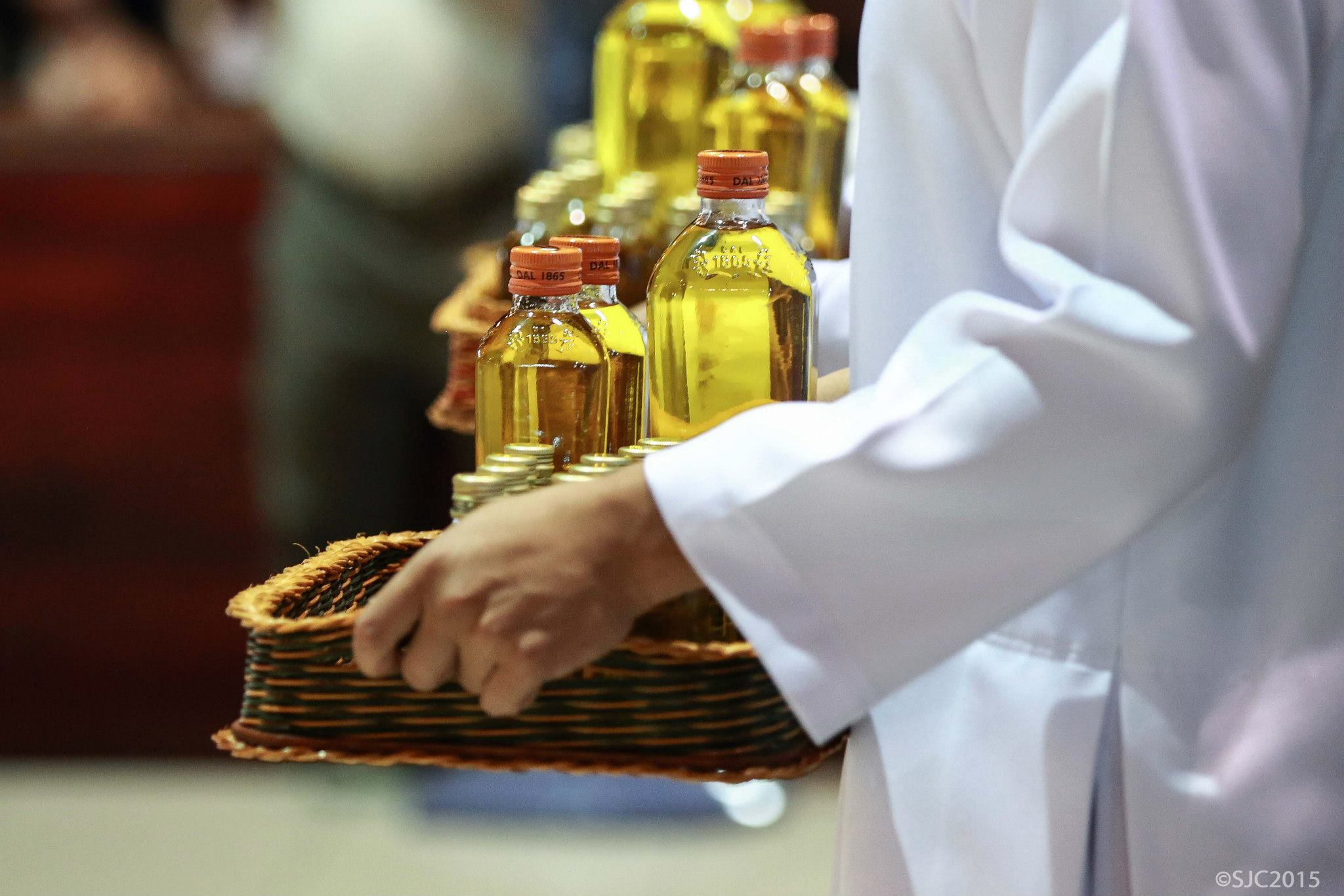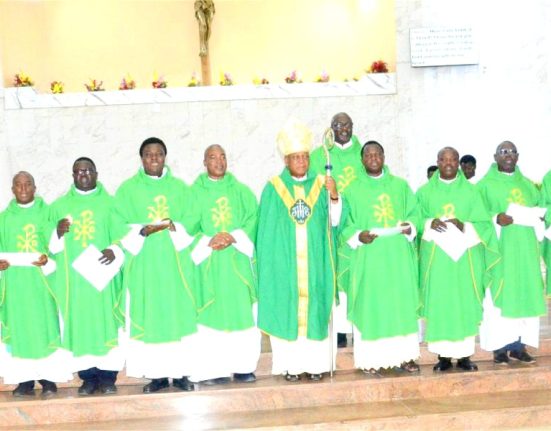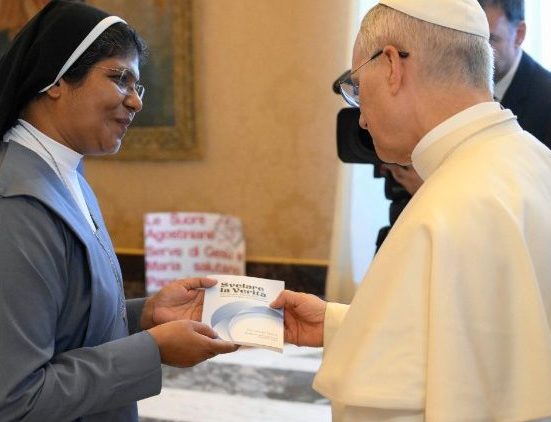Blessing of Holy Oils
The Chrism Mass is held during Holy Week in every Catholic (arch)diocese. In New Orleans, it is traditionally held on the Tuesday of Holy Week. During this mass, the priests, deacons and representatives of the entire archdiocesan community gather around the Archbishop, who blesses the Holy Oils for use in the coming year.
These are:
- Oil of the Sick
- Oil of Catechumens
- Sacred Chrism
Whenever the Holy Oils are used in a diocese, the ministry of the bishop who consecrated them is symbolically present.
Unity, Renewal of Vows and Promises
The Chrism Mass reminds us of our oneness in Christ through Baptism and its holy anointing, made possible by the ministry of the archbishop and his priests. The Chrism Mass is also a key moment in which the unity of the archbishop with his priests (together, they form the presbyterate) is manifested and renewed. During the liturgy, the entire assembly is called to renew its baptismal promises; deacons and priests also renew their vow of obedience to the local (arch)bishop and their commitment to serve God’s people. At the end of the Chrism Mass, the Holy Oils are brought back to parishes of the archdiocese for use in the coming year.
One Flock, One Eucharist Gathered Around the Bishop
The following statement from the Second Vatican Council can help us understand the significance of the Chrism Mass for the Church:
Ancient Greece and Rome
- Oil was used by ancient Greek and Roman athletes to limber up muscles; it was believed to bring strength and protection.
- Oil was also used for its healing properties, and poured on head as sign of belonging (for example, in the initiation of Roman soldiers).
Old Testament
- used to consecrate altars, sacred places, and sacred vessels
- used in anointing priests
- prophets were also considered anointed by God’s Spirit to speak powerfully, and with authority, in God’s name.
- kings were anointed (by prophets) to rule God’s people
- anointing also a sign of God’s strength, favour, joy of being God’s servant (See Ps. 45, 8: “God your God has anointed you with the oil of gladness…”)
- an important ingredient in preparing food that kept people alive
- used to add beauty to face; poured over the head of guests as sign of welcome.
II. The Messiah: God’s Anointed One
The biblical word for one who was anointed was messiah. Translated into Greek, the language of the New Testament, it becomes Christos, or Christ.
Jesus: God’s Anointed One:
When we call Jesus our Messiah, we are saying that he was anointed
by God to announce God’s word –the Good News of salvation- to God’s
people. In Luke, Jesus says: “The Spirit of the Lord is upon me, because He has anointed me to bring good news to the poor…” (Lk 4, 18ff)
Christians as Anointed Ones:
Baptism makes us Christians, that is, anointed ones who share in the
life of the crucified and risen Jesus, God’s anointed one. Immediately
before being baptized with water, we are anointed with the Oil of
Catechumens, which strengthens and purifies us. After baptism, with
water, we are anointed with the Oil of Chrism, which consecrates us as
members of Christ’s body who share in Jesus’ anointing as priest,
prophet and king. This anointing with Chrism gives us the Holy Spirit’s strength to live out our baptism. Anointing with Chrism at Confirmation completes the grace of Baptism, and seals us with the fullness of the Holy Spirit’s gifts.
III. Three Holy Oils:
This quote from the Catechism of the Catholic Church gives a good summary of the importance of the three holy oils:
Used in Sacrament of the Sick to bring the strengthening and healing power of Christ, who is at work in the Church by the action of the Holy Spirit. St. James writes: “Are any among you sick? They should call for the elders [priests] of the Church and have them pray over them, anointing them with oil in the name of the Lord. The prayer of faith will save the sick, and the Lord will raise them up, and anyone who has committed sins will be forgiven.” (Jas 5:14-15)Oil of Catechumens
The Oil of Catechumens is used at Baptism, to strengthen (with wisdom and courage to live the Gospel) and purify candidates (from original sin) before baptizing with water.
Holy Chrism
Holy Chrism is a mixture of olive oil (a rich oil, symbol of richness of God’s grace) and balsam fragrance (symbol of sweetness of Christian virtue). The Oil of Chrism is a sign of fullness of grace and spiritual strength; it consecrates and enables us to live out the call to follow Jesus the Christ (the anointed one) as baptized/confirmed/ordained Christians: “The holy chrism consecrated by the bishop is used to anoint the newly baptized, to seal the candidates for confirmation, and to anoint the hands of presbyters [priests] and the heads of bishops at their ordination, as well as in the rites of anointing pertaining to the dedication of churches and altars. The oil of the catechumens is
used in the preparation of the catechumens for their baptism. The oil of the sick is used to bring comfort and support to the sick in their infirmity.” (Ceremonial of Bishops, 274)
Use at Baptism:
Right after the actual baptism with water, the priest anoints the candidate on the crown of the head with Chrism saying: “God the Father of our Lord Jesus Christ has freed you from sin and given you a new birth by water and the Holy Spirit. He now anoints you with the chrism of salvation. As Christ was anointed Priest, Prophet, and King, so may you live always as a member of His body, sharing everlasting life. Amen.”
Use at Confirmation:
In the Sacrament of confirmation, the bishop anoints the forehead of the candidate with chrism saying, “Be sealed with the gift of the Holy Spirit.”
Use in Holy Orders:
When a man is being ordained to the priesthood his hands are anointed with the oil of chrism; and when a priest is being consecrated a bishop his head is anointed by the consecrating bishop with chrism.
Other Uses of Holy Chrism:
Holy Chrism is also used in the dedication ceremony of a church. Here, the bishop anoints the altar, pouring holy chrism on the middle of the altar and on each of its four corners. It is recommended that the bishop anoint the entire altar. After anointing the altar, he anoints the walls of the Church in 12 or fourteen places marked by crosses. It is also used to anoint the new bell of church.
IV. Blessing and Distribution of the Holy Oils
At the offertory, the three Holy Oils and balsam fragrance are carried up to the sanctuary with gifts of bread and wine.
The Oil of the Sick is blessed by the bishop during the Eucharistic Prayer. Thebishop then mixes the balsam fragrance into the Chrism, and blesses it, praying: “Make this chrism a sign of life and salvation for those who are to be born again in the waters of baptism. Wash away the evil they have inherited from sinful Adam, and when they are anointed with this holy oil make them temples of your glory, radiant with the goodness of life that has its source in you.”
As the bishop prays, the priests present with him extend their right hands toward the Chrism, signifying their participation in his authority, through which Christ himself sanctifies and builds up his body, the Church. When the Chrism is blessed, the Bishop breathes over the open vessel which contains it. This is a symbol of the Holy Spirit, who blew over the face of the waters before creation (Gen 1, 2b), and of the
risen Jesus, who appeared to his disciples and breathed on them saying “Receive the Holy Spirit…”(John 20, 22-23). It is the Holy Spirit who consecrates this oil through the Bishop’s invocation.
Finally, after the Chrism has been blessed, the Bishop blesses the Oil of
Catechumens. At the end of the liturgy, the holy oils are given to the deacons of the diocese, who distribute it to representatives of each parish. It is recommended that each parish keep the vessels containing the Holy Oils in a special clear glass cabinet called an ambry, where they can be viewed by all the faithful. Many newer churches have an ambry, which is usually located close to the baptismal font. It reminds all who see it of the anointing which unites and strengthens us to live as one body in Christ, and comes to us through ministry of his Church.
V. Conclusion
The Chrism Mass is a celebration of the entire Christian community:
- a community whose oneness comes from its union with the crucified and risen Jesus – God’s anointed one – through Baptism,
- a community that shares in the riches and consolation of Christ’s gift of the Holy Spirit through the sacramental ministry of its Bishop and priests,
- a community that gathers around its Bishop as one body made up of many parts, with Christ as its head.
Culled from www.nolacatholic.org











Leave feedback about this